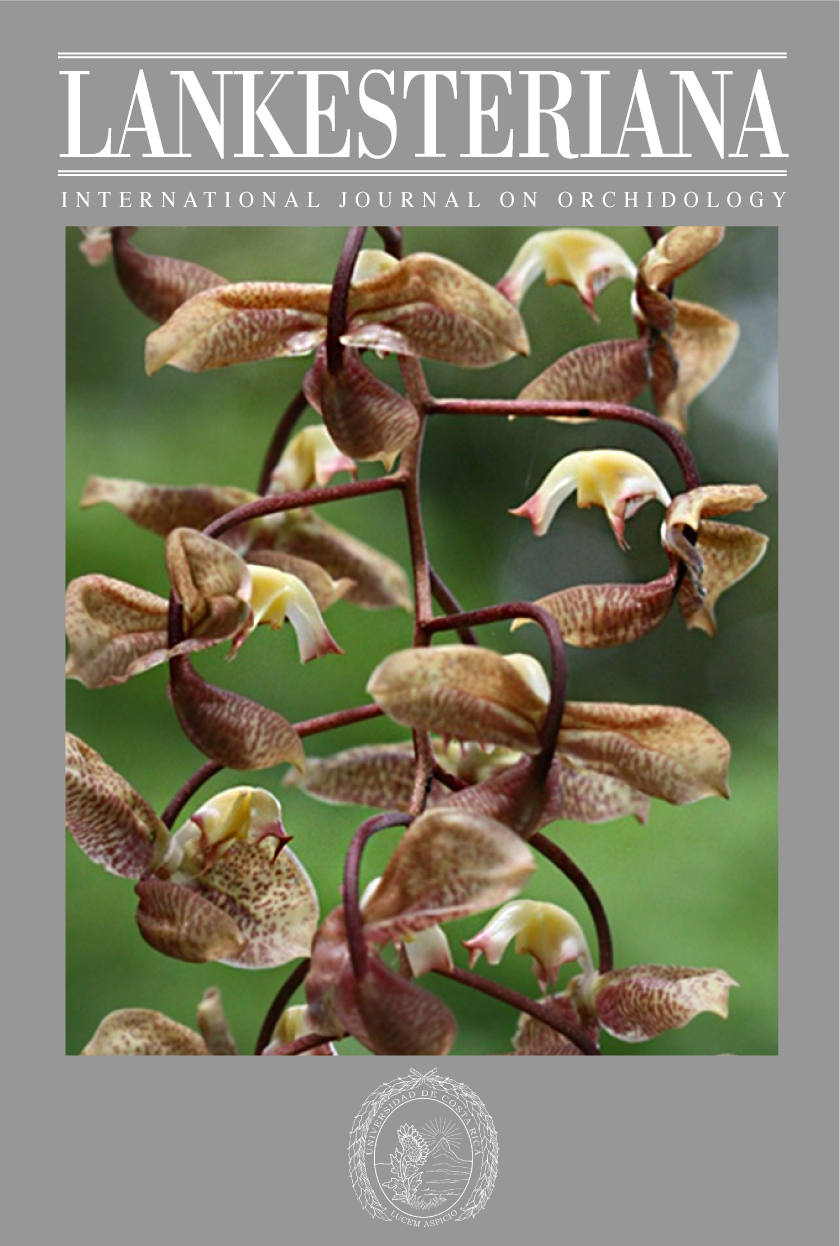First record of a natural hybrid of the genus <i>Gongora</i> (Stanhopeinae) and comments on the parent species
DOI:
https://doi.org/10.15517/lank.v23i1.54261Keywords:
Copán, Cymbidieae, Euglossini, Gongora cassidea, Gongora saccata, Honduras, OrchidaceaeAbstract
The first natural hybrid of the genus Gongora is described for the department of Copán in Honduras, between the species Gongora truncata and Gongora batemanii (synonym: Gongora cassidea). The nothospecies described here presents intermediate characteristics between both species, such as setaceous projections on the lip, a large callus, spatulate epichile, and a cucullate hard dorsal sepal. The identity of a specimen from the Herbarium Jany Renz Botanical Institute, University of Basel, Switzerland, corresponds to the same hybrid described here and erroneously determined as Gongora saccata, a synonym of Gongora seideliana, is considered. The clarification of the synonymy of Gongora saccata and relevant aspects regarding the pollination mechanisms and reproductive barriers of both parent species are also discussed.
Downloads
References
Ackerman J. D. (1989). Geographic and seasonal variation in fragrance choices and preferences of male euglossine bees. Biotropica, 21(4), 340–347. DOI: https://doi.org/10.2307/2388284
Ames, O. & Correll, D. S. (1953). Orchids of Guatemala. Fieldiana: Botany, 26(1).
Ames, O. & Correll, D. S. (1985). Orchids of Guatemala and Belize. Courier Corporation.
Beutelspacher, C. R. (2011). Guía de orquídeas de Chiapas. México: Universidad de Ciencias y Artes de Chiapas.
Chase, M. W., Toscano de Brito, A. L. V., Pridgeon, A. M., Cribb, P. J., Chase, M. W. & Rasmussen, F. N. (2009). Genera Orchidacearum, Volume 5: Epidendroideae (Part Two). Oxford: Oxford University Press.
Damon, A., Hernández-Ramírez, F., Riggi, L., Verspoor, R., Bertolini, V., Lennartz-Walker, M. & Burns, A. (2012). Pollination of euglossinophylic epiphytic orchids in agroecosystems and forest fragments in southeast Mexico. European Journal of Environmental Sciences, 2 (1), 5–14. DOI: https://doi.org/10.14712/23361964.2015.34
Dressler, R. L. (1968). Pollination by euglossine bees. Evolution, 22 (1), 202–210. DOI: https://doi.org/10.2307/2406664
Dressler, R. L. (1993). Phylogeny and classification of the orchid family. Cambridge University Press.
Eltz, T., Whitten, W. M., Roubik, D. W. & Linsenmair, K. E. (1999). Fragrance collection, storage, and accumulation by individual male orchid bees. Journal of Chemical Ecology, 25 (1), 157–176. DOI: 10.1023/A:1020897302355
Faegri, K. & Van Der Pijl, L. (2013). Principles of pollination ecology. Pergamon press.
García-Martínez, R. & Jiménez-Machorro, R. (2016). Redescubrimiento de Gongora seideliana Rchb.f. (Orchidaceae), una orquídea rara, en Chiapas, México. Lacandonia, 10 (2), 11–14.
Gerlach, G. (2003). La subtribu Stanhopeinae: sus notables mecanismos de polinización, la química de sus aromas florales e implicaciones en sistemática y taxonomía. Lankesteriana, 7, 104–106. DOI: 10.15517/lank.v3i2.23029
Gershenzon J. (1994). Metabolic costs of terpenoid accumulation in higherplants. Journal of Chemical Ecology, 20, 1281–1328. DOI: 10.1007/BF02059810
Grant, V. (1981). Plant Speciation. New York: Columbia University Press.
Hágsater, E. & Salazar, G. A. (1990). lcones Orchidacearum. Fascicle I. Orchids of Mexico Part, 1. México City: Herbario AMO. 45 pp.
Hetherington-Rauth, M. C. & Ramírez, S. R. (2015). Evolutionary trends and specialization in the euglossine bee-pollinated orchid genus Gongora. Annals of the Missouri Botanical Garden, 100 (4), 271–299. DOI: 10.3417/2014035
Hetherington-Rauth, M. C. & Ramírez, S. R. (2016). Evolution and diversity of floral scent chemistry in the euglossine bee-pollinated orchid genus Gongora. Annals of botany, 118 (1), 135–148. DOI: 10.1093/aob/mcw072
Jenny, R. (1993a). Stanhopea in Costa Rica & Panama. Schlechteriana, 4, 66–92.
Jenny, R. (1993b). Monograph of the genus Gongora Ruiz & Pavon. Koeltz Scientific Books.
Pupulin, F. (2007). × Bensteinia ramonensis, a new natural hybrid in the Zygopetalinae (Orchidaceae). Selbyana, 28 (2), 112–116.
Ramírez, S. (2019). Pollinator specificity and seasonal patterns in the euglossine bee-orchid mutualism at La Gamba Biological Station. Acta ZooBot Austria, 156, 171–181.
Roubik, D. W. & Hanson, P. E. (2004). Abejas de orquídeas de la América tropical: Biología y guía de campo. Editorial INBio.
Soltis, P. S. & Soltis, D. E. (2009). The role of hybridization in plant speciation. Annual review of plant biology, 60, 561–588. DOI: 10.1146/annurev.arplant.043008.092039
van der Pijl, L. & C. H. Dodson. (1966). Orchid flowers, their pollination and evolution. University of Miami Press. 214 pp.
Williams N. H. & Dodson C. H. (1972). Selective attraction of male euglossine bees to orchid floral fragrances and its importance in long distance pollen flow. Evolution, 26, 84–95. DOI: https://doi.org/10.2307/2406985
Williams, N. H. & Whitten, W.M. (1983). Orchid Floral Fragrances and the Male Euglossine Bees: methods and advances. Biological Bulletin, 164, 355–395. DOI: 10.2307/1541248

Published
Versions
- 2023-02-28 (2)
- 2023-02-27 (1)
How to Cite
Issue
Section
License
Copyright (c) 2023 Lankester Botanical Garden, University of Costa Rica

This work is licensed under a Creative Commons Attribution-NonCommercial-NoDerivatives 3.0 Unported License.
According to the Open Access policy promoted by the University of Costa Rica, all the papers published by Lankesteriana are licensed under the Creative Commons copyright and can be downloaded free of charge. The journal holds copyright and publishing rights under the CC BY-NC-ND 3.0 CR license.
Before the publication of the materials submitted by the author(s) in LANKESTERIANA, the author(s) hereby assign all rights in the article to the Lankester Botanical Garden.




